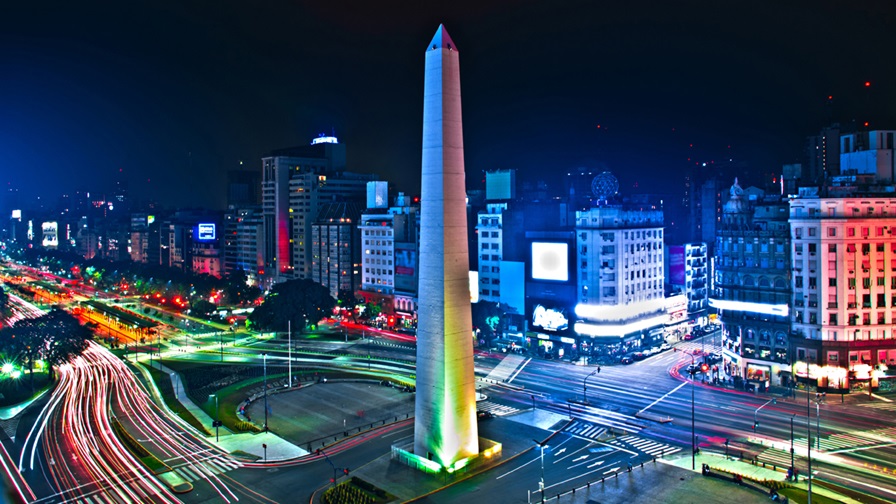
Spotlight On Buenos Aires

Along the Rio de la Plata, stands passionate as the tango, Buenos Aires, the most elegant city in South America. La Reina del Plata sings the lyrics of a tango. A true mosaic of modern buildings coexist with old colonial mansions, museums, theaters, cafes and music halls, able to soak in art, cuisine, culture and of course the tango.
Buenos Aires is Argentina's cosmopolitan door. The strong European immigration, helps to characterize it's international character and charm. You'll feel influences of Spain in the Plaza de Mayo, Italian in La Boca and French along the streets of Alvear and Arroyo. You will never run out of things to do. The city is made up of 50 neighborhoods where you will find around 100 cinemas and 60 theaters, 80 museums, 700 art galleries, more than 10 football stadiums, a hippodrome, and several polo fields and golf courses. The fifty neighborhoods of the city tell their story while retaining their own characteristics and peculiarities.
Historic Center
The center of Buenos Aires is one of the most vibrant and historic areas of the city. In this area is where you will find governement buildings, as well as shopping. Thus, while the nostalgic memories shakes Plaza de Mayo and Casa Rosada returns to mind images of the most famous of Argentina's recent history, life moves fast through the streets nearby: Corrientes Avenue and Florida Street . For these flows the activity of the city at a frantic rate: As usual street performers flooded the streets to beat a crowded time, tourists are confused intertidal executive locals and passers accelerated.
Plaza de Mayo
Avenida Rivadavia and Bolvar Esq
Transport: Metro line A (Plaza de Mayo), D (Cathedral) and E (Bolivar)
http://www.madres.org/
This is perhaps the best known of Buenos Aires is the most emblematic and, in turn, the nerve center of government power. The square, like the rest of the historic district, was designed by Juan de Garay and buildings housing the symbol of the great powers: the Casa Rosada, the Bank of Argentina, the Metropolitan Cathedral and the Cabildo. Here, in addition, meets every Thursday the Association of Mothers of the Plaza de Mayo to remind your country and the world that still do not know the whereabouts of their missing.In the center, the Pyramid of May (1811) stands proud as the oldest monument of the city and as a reminder of that first anniversary of the revolution that eventually brought independence to Argentina.
Cabildo of Buenos Aires and Historical Museum of the Revolution
Bolivar, 65
Transport: Metro line A (Plaza de Mayo), D (Cathedral) and E (Bolivar)
Museum Hours: From 10.30 to 17.00, Tuesday to Friday, Sunday: 11.30 to 18.00 h.Saturdays and Mondays closed.
Free admission. Guided tours: Fridays at 15 h. and Sunday at 14.00 h., free and Sundays at 12.30 h. and at 15.00 h., $ 3.
Tel: 11 4342 6729
The Cabildo of Buenos Aires is home to the city council of the capital and former seat of the movements fighting for independence. Built in 1610, was shortly after undergoing a reform that white arches that characterize its facade now spread all over the Plaza de Mayo. Although the arches became eleven, only these days you can see the five that remained when the surrounding avenues improvements to the City Council in 1889 required the demolition of the rest. Inside the building, a modest museum displays memorabilia of the British invasions of the nineteenth century, modern paintings of colonial and early independence, and religious art of the missions of the Jesuits and other orders.
Government Palace in Buenos Aires
Bolivar, 1
Transport: Metro line A (Plaza de Mayo), D (Cathedral) and E (Bolivar)
Hours: Guided tours, Saturdays at 16.00 h. and at 17.00 h. and Sunday every hour from 11.00 h. at 17.00 h. Tel: 11 4323 9489
This is one of the buildings that line the historic Plaza de Mayo, in front of City Hall. Dial French style, with Italian influence, according to the design of other buildings in the area, the building deserves at least a brief stop.
Casa Rosada
Balcarce, 50
Transport: Metro line A (Plaza de Mayo), D (Cathedral) and E (Bolivar)
http://www.presidencia.gov.ar/
Government House Government House is the home to Argentina and the presidential offices, and agencies of the presidency as we tend to think (It is, in fact, in Los Olivos, on the outskirts of the capital, home to presidents-elect) . Government House was built over an old fort and houses of Viceroys. Although the side facing the Plaza de Mayo and from whose balcony Evita addressed his people is the most famous, is necessary to surround the building to see the main entrance.
Museum of the Casa Rosada
Hipolito Irigoyen, 219
Transport: Metro line A (Plaza de Mayo), D (Cathedral) and E (Bolivar)
Hours: 10 to 18 pm Monday through Friday, tours of 11.00 to 15.00 h, Sunday from 14.00 h a18.00-guided tours at 16.00. Saturday closed.
Admission: Free
Tel: 11 4344 3802
http://www.museo.gov.ar/default.asp
Just across the street from the Casa Rosada access to the Museum of the Casa Rosada in to do a brief tour of Argentina presidential history. It should be noted that only those listed in the genealogy who ruled until a minimum of 30 years, maybe so convulsed and sensitivity of the country's recent history.
Columbus Park
Paseo Colon Av
Transport: Metro line A (Plaza de Mayo), D (Cathedral) and E (Bolivar)
In this large park, which extends off the main entrance of La Casa Rosada, the Monument to Christopher Columbus, Florentine work of Arnaldo Zocchi, made of marble.
City Museum
Adolfo Alsina, 412
Transport: Metro line A (Plaza de Mayo) and E (Bolivar).
Hours: 11 h. to 19 h. Monday to Sunday, including holidays.
Admission: General, $ 1. Mondays and Wednesdays, free.
Tel: 11 4331 9855
http://www.museos.buenosaires.gov.ar/ciudad.htm
The Museum of the City of Buenos Aires makes a fascinating tour of its history, its architecture, the customs of its people and its cultural and artistic events. Old photographs, paintings, furniture, details and artifacts of various kinds are the highlights of a trip through the present and past the city.
Block of Lights
Peru, 272
Transport: Metro line E (Bolivar)
Timetable: 11.00 h. to 19.00 h. Monday through Friday, from 15.00 h. to 19.00 h.Saturday and Sunday. Guided tours: Monday to Friday at 15.00 h., Saturday and Sunday 15.00 h., 16.30. and 18.00 h. Monday, free entry to the Jesuit Procadura at 13.00.
Free admission. Guided tours, $ 6 to $ 7
Tel: 11 4331 9534
http://www.manzanadelasluces.gov.ar/principal.html
This complex of historic buildings south of the Plaza de Mayo stands out for having been the main training center of the capital and religious landmark, its architectural and cultural past, particularly by the number of institutions thronged. Here is the Church of San Ignacio, built by the Jesuits who settled in this lot in the early eighteenth century, which is the oldest in the city. Next to her, still remain two of the buildings of the Jesuit ProcadurÂa, and around them, succeed cultural institutions that brought fame to this place: the University of Buenos Aires, the elite National School of Buenos Aires, the former House of Representatives and the Public Library, among others. Such was the importance of the enclave in 1821 inspired the newspaper Argos to name it "The Apple of Lights" because of his "inner wealth" in a time when it was the intellectual center of the city. In 1992, tunnels were discovered in her defense that can now be visited.
Ethnographic Museum John B. Ambrosetti
Moreno, 350
Transport: Metro line A (Plaza de Mayo), D (Cathedral) and E (Bolivar)
Hours: 13.00. to 19.00 h., Tuesday to Friday, Saturday and Sunday, from 15.00 h. to 19.00 h. Guided Tours: Saturday and Sunday at 16.00 h.
Admission: A contribution of $ 2.
This museum displays archaeological and anthropological interesting collections, whose objects have been collected over Argentina and other parts of South America.
Metropolitan Cathedral
San Martin, 27
Transport: Metro line D (Cathedral) and A (Peru)
Hours: 8.00 am to 19.00 pm, Monday to Friday from 9.00 am to 19.30 pm, Saturdays and Sundays. Guided tours: Monday to Friday 11.30 h, 13.15 h and 15.30 h. Saturdays at 15.30 pm and Sundays at 15.30 am (children only)
Admission: Free
http://www.catedralbuenosaires.org.ar/
It is, in the cathedrals of the city, without a doubt the most important. It was built on an old colonial church was not finished until 1827. In it, include bas-reliefs of the facade on neoclassical columns. Inside the temple you can admire a life-size Christ in wood of carob and the altar, Rococo style. Inside the temple is the tomb of Jose de San Martin, hero of independence who, though he died in France, later was returned to this place. A torch burns at the doors of the temple in his memory.
Calle Florida and Avenida Corrientes
They go to Buenos Aires with the intention to buy or not, it's worth dropping by these two streets that converge to each other defining the boundary of the historic center. Both full of movement and life, are shown from the bustle with which Argentines live their city. Calle Florida, the most commercial, worth a visit and Corrientes Avenue, with its bookstores, literary cafes, theaters and pizzerias, is the perfect place to simply watch and enjoy a coffee or company.
Central Post
Sarmiento, 151
Transport: Metro line B (LN Alem)
Free admission, but is currently closed for renovations.
Tel: 11 4316 3000
The Central Post Office is one of the buildings surround the city of Buenos Aires, with its French style architecture, excellent maintenance and its imposing dimensions. It was conceived as a projection of the post office in the city of New York. In use since 2003, will soon become the Bicentennial Cultural Centre, coinciding with the 200th anniversary of Independence of the country in 2010.
Puerto Madero
If there is an environment in all of Buenos Aires invites you really relax and disconnect that is Puerto Madero, the renovated port area of the capital. The ambitious renovation that has resulted in an interesting complex of docks, warehouses and large rusty cranes conveyors, life has returned to a port that had collapsed more than a century and was therefore abandoned after little more than two decades of operation. Now the dynamic and modern harbor dotted with restaurants, cafes and hotels dazzling, is again out of Buenos Aires to its river of silver and the world. However, the Costanera Sur Ecological Reserve extends, meanwhile, gentle on the banks of the River Plate, which, though curious eye jealously hides, water marshes that lie beside him, drawing a unique setting for observation, meditation and rest.
